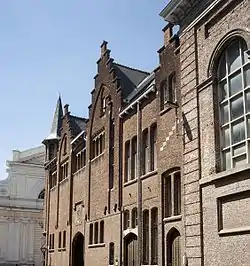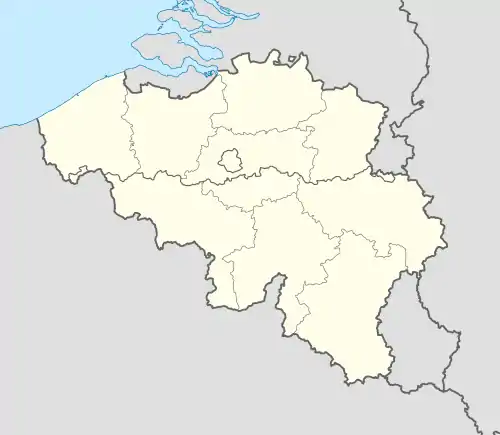Abdij van Oosteeklo | |
 Modern school on the former site of the abbey in Ghent | |
 Location within Belgium | |
| Monastery information | |
|---|---|
| Order | Cistercian nuns |
| Established | before 1217 |
| Disestablished | 1796/1842 |
| Site | |
| Coordinates | 51°11′00″N 3°41′12″E / 51.183419°N 3.686711°E |
Oosteeklo Abbey was a Cistercian nunnery founded in Oosteeklo in 1217 and later moved to Ghent.
History
In the Middle Ages the lay brothers and the secular tenants of the monastery played an important role in the agricultural development of the sandy heathland around the village of Oosteeklo.
In 1577, during the Dutch Revolt, the abbey was plundered and razed. Seven surviving members of the community regrouped under Abbess Elisabeth Fransmans and in 1585 moved into the Posteernehof in the city of Ghent.[1] Under Joanna de Hertoghe (died 1630), the abbey church was built in Ghent, and under Francisca vanden Steene (abbess 1636–1668) the refectory, chapter house and infirmary were built and the church decorated.[2] While established in Ghent the monastery did retain extensive property and rights in and around Oosteeklo. Their former guesthouse in the village is now listed as built heritage.[3] On 11 May 1666 Gerard de Baere, Abbot of Dunes, granted permission for a chapel with portable altar to be built on the former site of the abbey in Oosteeklo.[4]
In 1796 the Revolutionary authorities suppressed the house in Ghent and confiscated the building, which in 1797 was sold at public auction. The former nuns bought back the house through a front man, and continued to live in it as a clandestine community until 1814, when again officially recognised as a monastic house. Over the course of the subsequent few decades, the community died out. In 1842 the former monastery buildings were transferred to the Jesuits, and in the early 20th century to the De La Salle Brothers.[5]
Abbesses
The abbesses listed in the Gallia Christiana, vol. 5 (Paris, 1731), 227–228, are as follows.
- Isabella (died 1230)
- Egidia de Salsyne (died 1267)
- Lyna Trys (died 1286)
- Lyna de Boulers (died 1288)
- Ida Dammand (died 1290)
- Agnes van Hove (died 1308)
- Heylsoeta de Rocleers (died 1310)
- Maria Keelcapons (died 1322)
- Belina van Somerghem (died 1333)
- Clara Tollins (died 1364)
- Margareta vanden Berghe (died 1382)
- Margareta van Wilsem (died 1405)
- Catharina d'Appers (died 1440)
- Margareta vanden Voorde (died 1442)
- Catharina Seysens (died 1468)
- Clara Smeyers (died 1478)
- Christiana Laus (died 1488)
- Catharina van Raveschot (resigned after 14 months)
- Margareta Poleyts (died 1492)
- Agnes Cabelliau (died 1499)
- Gentina de Mastin (died 1504)
- Catharina de Beer (died 1527)
- Anna de Pottelsberghe (died 1531)
- Philippina de Mastin (died 1536)
- Johanna Sanders (died 1583)
- Elisabeth Fransmans (died 1610)
- Joanna de Hertoghe (died 1630)
- Maria de Brunswyck (died 1634), daughter of the Duke of Brunswick
- Francisca vanden Steene (died 1668)
- Isabella Clara Eugenia de Huchin, a goddaughter of Isabella Clara Eugenia (died 1722, aged 92)
- Juliana vanden Bogaerde of Bruges (died 1725, aged 66)
- Maria Alexandrina Coene of Ghent (enthroned 2 September 1725)
References
- ↑ Het Rijksarchief in de provinciën: De Vlaamse provinciën (Brussels, 1974), p. 174.
- ↑ Gallia Christiana, vol. 5 (Paris, 1731), 228.
- ↑ "Abdij zusters bernardinessen: Gastenkwartier".
- ↑ "Abdij van Oosteeklo. Gent".
- ↑ "Abdij van Oosteeklo te Gent".